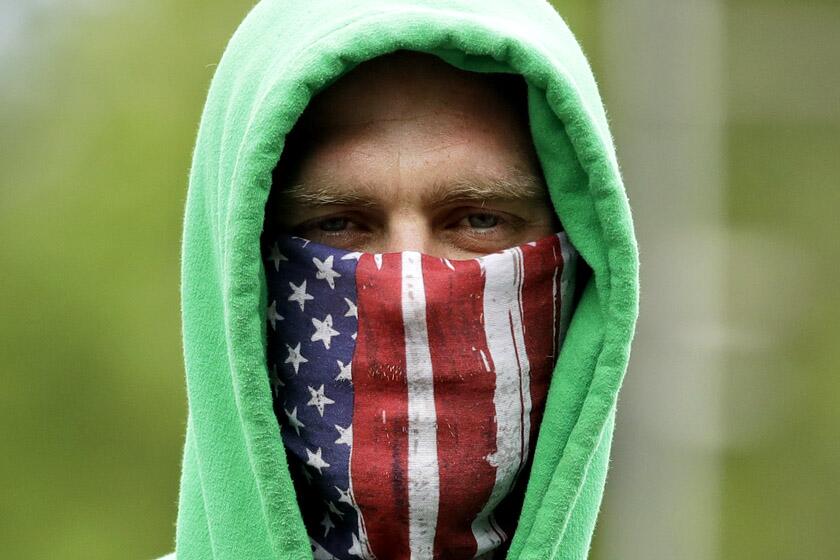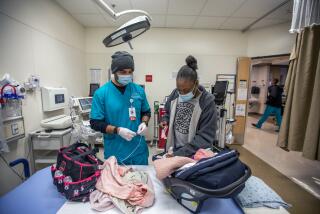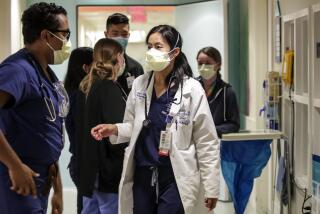Among healthcare workers, the toll of COVID-19 falls hardest on nurses
The sudden appearance of a deadly new pathogen is always bad for the men and women who care for the afflicted, and a new report shows that the coronavirus that causes COVID-19 is no exception.
In a three-month period early in the COVID-19 pandemic, when personal protective equipment was often scarce and scientists’ understanding of the virus was in its earliest stages, healthcare workers were hospitalized and died at rates that were atypically high for their ages and genders.
Researchers scoured a sample of 6,760 adults hospitalized for COVID-19 between March 1 and May 31 and found that 5.9% of those patients were healthcare workers. Just over two-thirds of them were in jobs where they would likely have direct contact with patients — especially nursing.
Despite being mostly female and typically younger than the general pool of hospitalized COVID-19 patients, the healthcare workers had rates of serious illness and death that were similar to those seen in older patients — especially men, who have proved to be more vulnerable to the disease.
More than a quarter of the COVID-19 patients who identified as healthcare workers became sick enough to be admitted to the intensive care unit. Roughly 16% required the assistance of mechanical ventilation to breathe. And 4.2% died during their hospitalization.
The median age of the hospitalized healthcare workers was 49, 13 years younger than the median age for the entire group of 6,760 COVID-19 patients. And although men who develop severe cases of COVID-19 generally outnumber women, 72% of the healthcare workers hospitalized for COVID-19 were female, reflecting women’s larger numbers in nursing and related healthcare fields.
If nearly all Americans would wear face masks when they leave their homes, they could save over 100,000 lives by the end of February, a study says.
But other factors placed the hospitalized healthcare workers squarely in groups at high risk of developing severe disease.
Nine out of 10 had an underlying health condition that increased their vulnerability, such as hypertension, asthma, heart disease or diabetes. Almost three-quarters were identified as obese, a powerful risk factor for a serious case of COVID-19. And more than half — 52% — were Black Americans.
In part because Black people are heavily represented among “essential workers,” coronavirus infection rates have run three times higher in counties with predominantly Black populations than in counties that are predominantly white, and COVID-19 death rates are six times higher. The longstanding health inequities that contribute to higher rates of diabetes, asthma, hypertension and obesity among Black Americans are also driving their disproportionately high COVID-19 mortality rate, researchers say.
The new report was prepared for the Centers for Disease Control and Prevention by COVID-NET, a network of researchers tracking COVID-19’s impact from more than 250 acute-care hospitals in 14 states. Their findings were published Monday in the CDC’s Morbidity and Mortality Weekly Report.
At a time when healthcare workers are stretched to the limit, COVID-19 threatens to hobble a crucial workforce. The researchers said their findings underscored that adequate supplies of personal protective equipment, scarce throughout the pandemic, were crucial to keeping healthcare workers healthy and on the job.
Doctors have been highly visible in calls to shore up stocks of protective safety gear. But in the new study, they were far less likely than nurses to have been hospitalized for COVID-19.
Fewer than 3% of healthcare workers counted in the study were physicians. By contrast, nurses and certified nursing assistants amounted to close to four-in-10 of healthcare workers who landed in the hospital. (Phlebotomists, home healthcare aides, hospital housekeeping and maintenance staff, and other workers rounded out the list, though no other single group accounted for more than 6.6% of hospitalizations in the study.)
For nurses up and down the hierarchy, such findings are particularly important.
“This is not rocket science,” said healthcare expert Barbara Resnick of the University of Maryland’s School of Nursing, who was not involved in the new study. “Nurses are providing direct care to patients, and you have to be up close and personal for a lot of what they do. They spend the most time with patients, especially the nursing assistants. Bathing, dressing and giving medications — you can’t do that from six feet away.”
While doctors have relatively brief encounters with patients, nurses are more likely to spend more time in close contact with those sick with COVID-19, Resnick said.
Nurses around the world are risking their lives tending to coronavirus patients.
Across the country, nurses have sat by the bedsides of sick patients in lieu of families, or held phones connecting patients with their loved ones who have been barred from visits during the pandemic. That means they’re probably exposed to a higher dose of the coronavirus — a factor in causing more severe illness, Resnick added.
Roughly 17 million U.S. residents are employed in the nation’s healthcare sector. The new study is based on a sample of hospitalized patients in 98 counties in 13 states. It’s not clear whether the sample reflects the country as a whole. Nor is it clear whether healthcare workers will continue to be hospitalized and die at rates seen in the pandemic’s early months.
But if the trends seen in the study continue, more than a million healthcare workers could be hospitalized with COVID-19, and more than 42,000 of them could die by the time the pandemic is over.








